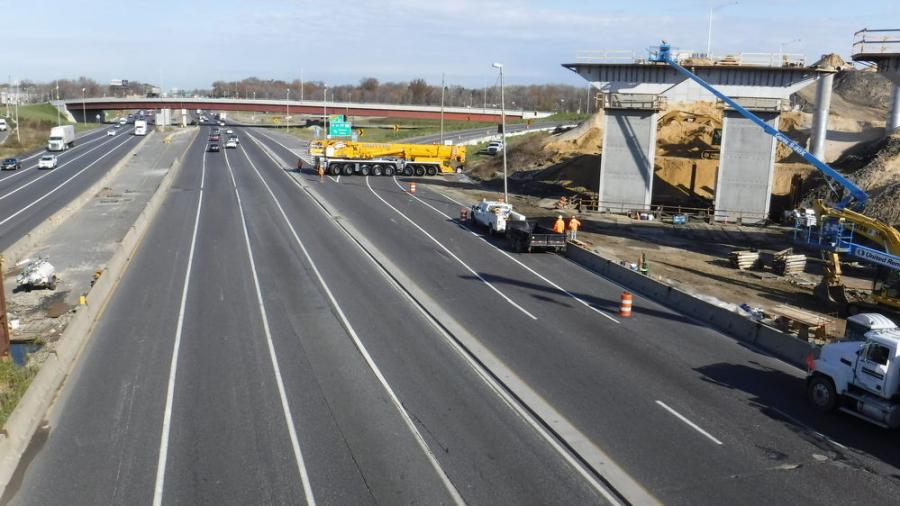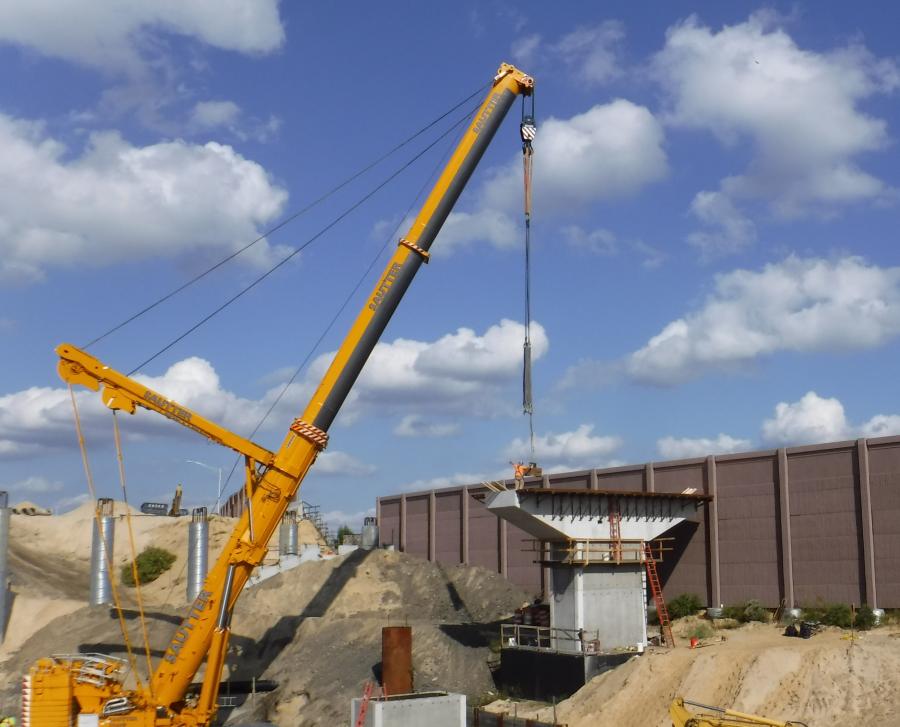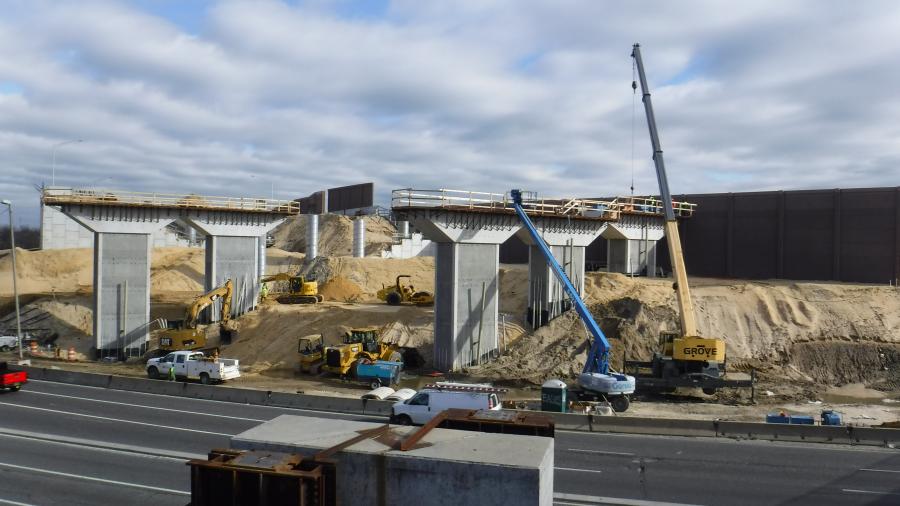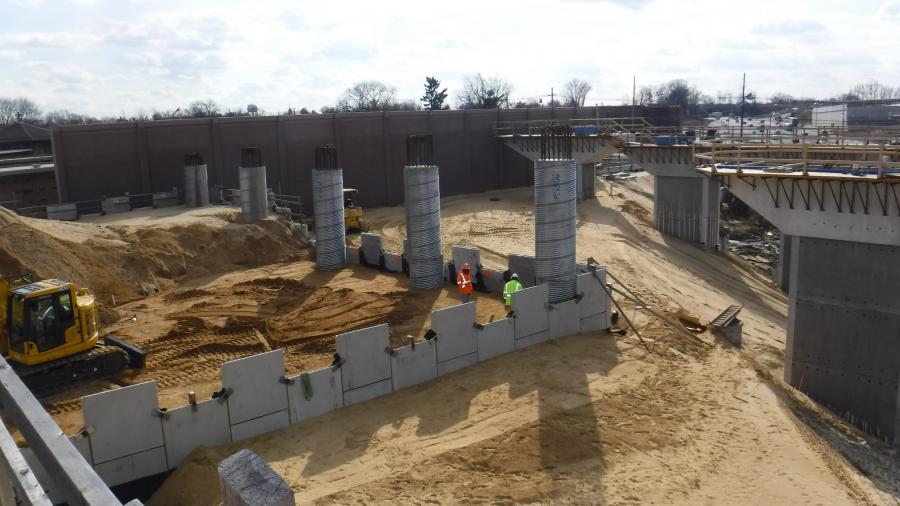“The project consists of three major highways,” said Direct Connection Contract 3 project engineer Bill Gaus. “I-295, which is a major north-south interstate in New Jersey that parallels I-95, which goes through Philadelphia, and I-76, which turns into NJ Route 42, which is a major highway between southern New Jersey, including the southern Jersey Shore and Philadelphia.
In an effort to improve safety and reduce traffic congestion at the intersection of I-295, I-76 and Route 42, crews in Camden County, N.J., are hard at work on the multi-year Direct Connection project. Contract 3 work currently is under way, at a cost of $205 million.
"The main focus is completing the I-295 mainline bridge that provides the direct connection over I-76/Route 42," said Stephen Schapiro, deputy manager of communications of the New Jersey Department of Transportation (NJDOT). "There are four bridges in this contract, including I-295 over Route 42/I-76 and over Browning Road; Ramp A Bridge from Route 42 northbound to I-295 northbound over Route 42 northbound and Browning Road; the permanent Browning Road over Route 42/I-76; and the temporary Browning Road bridge."
The overall project calls for improvements to several ramps, as well as the reconstruction of a number of bridges over I-295 and Route 42. The work will allow I-295 traffic to flow continuously without the need for using the current ramps with 35 mph speed limit. This means reduced congestion and improved safety by eliminating several weaving motions.
Because of the size and complexity of the project, it was split into four construction contracts. Construction began in the winter 2013 and is expected to be complete in 2027. When work under Contract 3 is completed, I-295 southbound traffic will begin using the new bridge, but I-295 northbound traffic will not do so until new ramps are built under the fourth and final contract.
"Building the bridges in this contract requires using several stages and traffic shifts," said Direct Connection Contract 3 project engineer Bill Gaus. "Construction starts on the outsides of Route 42/I-76 or widened portion of Route 42/I-76. As work progresses, Route 42/I-76 traffic patterns are shifted several times to allow for pier work in the center of the Route 42/I-76 WB roadway. Since I-295 and Ramp A are over top of Route 42/I-76 and the Browning Road Bridge, most of the Browning Road Bridge must be complete before I-295 and Ramp A girders are set.
"Work begins with temporary sheeting to support excavations. This allows for the construction of piles and drilled shafts on which we have cast-in-place foundations. The I-295 Bridge and Ramp A Bridge use pre-cast column segments and pre-cast pier caps on which continues a cast-in-place cap portion. Abutments are built directly on piles or drilled shafts with a pre-cast retaining wall. Steel girders are set on the abutments and piers, followed by the deck concrete."
Gaus noted that I-295 Direct Connection bridges have separate northbound and southbound curved steel bridges.
"The two bridges will use about 12.5 million pounds of structural steel. The northbound bridge will be four-spans, totaling 1,098 feet. The southbound bridge will be a four-span continuous unit with a single-span, totaling 1,072 feet. Ramp A will be an eight-span bridge totaling 1,318 feet and will use about 4.6 million pounds of structural steel."
The biggest challenge on the project is constructing a complex series of roads and bridges in a highly populated area with high traffic volumes.
"The project consists of three major highways," said Gaus. "I-295, which is a major north-south interstate in New Jersey that parallels I-95, which goes through Philadelphia, and I-76, which turns into NJ Route 42, which is a major highway between southern New Jersey, including the southern Jersey Shore and Philadelphia.
"This is a major commuter route with high volume, which sees even higher volume during the summer. To minimize the impact of construction, we are maintaining the same number of lanes throughout the life of the project because of the high traffic volume. Other challenges include coordination of the staged sequence work activities."
The main work taking place now is the delivery of pre-cast piers and assembling them in the field, and constructing abutments utilizing cast-in-place concrete and pre-cast modular retaining walls.
Work has started on the I-295 bridge and the ramp from Route 42 northbound to I-295 northbound. This includes work on abutments and a few piers. Many of the retaining walls, associated roadway construction and noise walls throughout the project limits have been completed. The abutments and center pier are complete for the temporary Browning Road Bridge. A majority of drainage work is complete, as well as most of the preliminary utility work on Browning Road.
As for tasks that have yet to be completed, NJDOT is in the process of securing additional work area needed for the temporary Browning Road bridge assembly.
"Once that is done, the temporary Browning Road Bridge over Route 42/I-76 can be installed," said Gaus. "The temporary bridge will allow the existing bridge to be demolished, additional road widening to commence, followed by the traffic shifts to allow for the remaining bridge work to start. Additional retaining and noise walls can also start."
For this project, many common types of heavy highway and bridge equipment are being used, including small to very large cranes (both crawler and tire types), excavators, front-end loaders, combination backhoes and graders. Several size rollers, milling machines, pavers, HMA load transfer machines, pile driving equipment, drilled shaft equipment, man-reaches and lifts of various types also are needed.
Materials required include various types of soil aggregates, hot-mix asphalt and concrete. There are various types of drainage pipes and sizes (concrete, HDPE, ductile iron, etc.), and the project is using pre-cast concrete piers and pre-cast concrete retaining walls.
Drilled shafts were selected to limit vibration and noise, instead of driven piles, because of the proximity to adjacent homes, a church and cemetery. In addition, the project site has varied soil strata, so drilled shafts were chosen for the largest load-bearing foundations.
Approximately 250,000 cu. yds. is scheduled for excavation as part of Contract 3, with approximately 200,000 cu. yds. of embankment. The most time-consuming part of this phase of construction is completing the I-295 bridge over Route 42/I-76, because it must be carried out in several stages and requires traffic shifts to build the center piers. The department needs to maintain a minimum number of lanes in all directions at all times.
For the most part, the elements are not a factor. Only the coldest weather and large amounts of snow will slow construction.
The current phase of construction began in April 2017, and is expected to finish in late 2024. South State Inc. serves as the primary contractor for this work.
Contract 4 is expected to go to bid 2022 and begin construction shortly after. It will include the completion of work along I-76/Route 42, I-295 northbound, the ramp from I-295 south to I-76 west and the remainder of the ramp from I-295 south to I-76 east/Route 42 south. CEG
Today's top stories


















